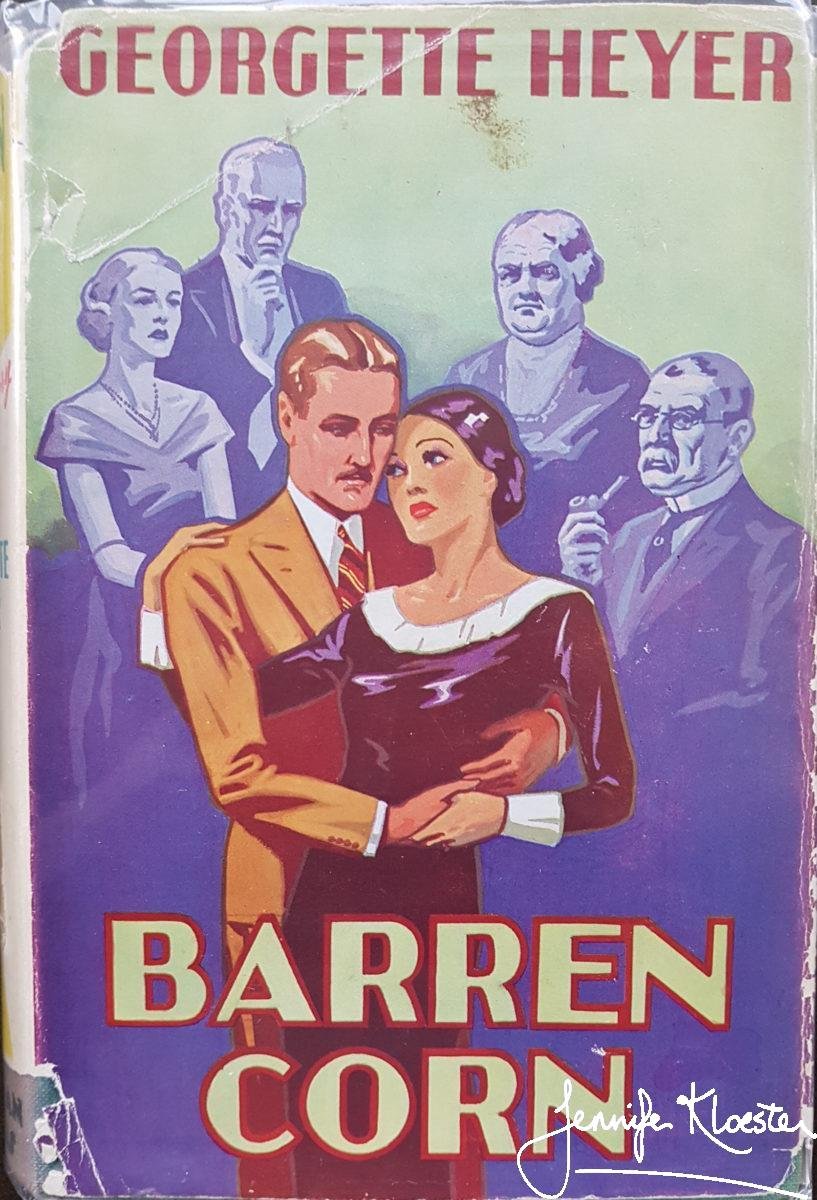Georgette Heyer wrote her fourth and final modern novel while living in Kratovo, a small village in Macedonia. Barren Corn is the story of Laura Burton, an intelligent, lower-middle class woman from Brixton, and Hugh Salinger, a handsome, selfish member ‘of the Leisured Class’, who meet on the French Riviera one summer after the First World War. Against all her instincts and her better judgement, Laura is persuaded by Hugh to marry him. They have an idyllic honeymoon in Italy before unexpected news takes them home to England where the apparently mismatched couple must face the consequences of their decision. Barren Corn is Georgette’s most ambitious and compelling contemporary romance and the only one of her novels to deal directly with the issue of class in English society. From the beginning, Laura sees the class difference between herself and Hugh as insurmountable, whereas Hugh decides that he can change her – mould her into ‘a creature made perfect’, so that even his mother will ‘forget the accident of her birth.’

Inspired by Swinburne
The title of the novel comes from a line in Felise, a poem written by the famous English Poet Algernon Swinburne. In the poem a man’s passionate love for Felise lasts only a year before it withers and dies and he must tell her that he no longer loves her. In Barren Corn, Hugh Salinger’s weak character is revealed through his continuing refusal to treat Laura honestly. In the novel Heyer has much to say about who really has ‘class’ and what it is that makes a person worthwhile. Laura’s struggle with the English class system, its repressive nature and damaging judgements have a profound effect on the young wife and the novel becomes a study in psychology as much as a story about a failed relationship.
Who knows what word were best to say?
For last year’s leaves lie dead and red
On this sweet day, in this sweet May,
And barren corn makes bitter bread.
What shall be said?
Algernon Swinburne, Felise.
A loving father
Georgette’s father, George Heyer, like many Oxbridge undergraduates of his day, was a great admirer of Algernon Swinburne’s poetry. Swinburne was enormously influential in the late nineteenth and early twentieth centuries and it was he who invented the Roundel, a poetic form which George Heyer experimented with in his own poetry. George would have read Swinburne’s poems aloud to Georgette just as he read her Shakespeare, Dickens and the Renaissance poets. As a child Georgette actually met Swinburne, who used to walk daily from his home in Putney to Wimbledon where she lived. Felise is a sad poem and its influence permeates Georgette’s final contemporary novel.

Rated high
Barren Corn is the only one of Georgette Heyer’s novels to examine deeply the psychology of an enduring, dedicated love – a love so strong as to be utterly self-sacrificing – albeit for the wrong reasons. It is an unusual book which could have made a gripping film and it caught the attention of several reviewers, including the American critic, Isabelle Wentworth Lawrence, who wrote regularly for the Boston Evening Transcript. She was much struck by Barren Corn, rating it high among Georgette’s novels:
The story is beautifully written, with that smooth precision of Miss Heyer’s which seems to be effortless. There is never a word too many. There is never a word too few. Underneath the somewhat cynical style with which she portrays England’s Ruling Order, runs the same compelling force which makes her historical romances so unusual, and fascinating.

Snobbery & psychology
In some ways Barren Corn was a conduit through which Georgette finally gave voice to some of her thoughts about sex, religious beliefs about life after death and the problem of class in British society. It is a surprisingly empathetic novel and, whether she meant to or not, in telling Laura’s story Georgette demonstrated a deep understanding of aspects of the human psyche and the kinds of mental traps into which individuals can fall when driven by love or sexual desire. She sees clearly the great class divide and explores its bitter consequences for Hugh and Laura when they attempt to bridge the chasm of cultural and social difference that comes to lie between them after their marriage. By the end of the novel, her heroine finds herself in a kind of mental and emotional limbo – a personal hell from which there is no escape if she is to spare her own family pain and abide by the code of conduct laid down by her husband and his class. Barren Corn is as much about snobbery as it is about the worth of the individual, a point which Isabelle Wentworth Lawrence noted with some relish:
What gives it its distinction is that, hand in hand with the romance goes an astonishing outlook on society. The entire novel might be a treatise on socialism, were it not so aristocratic. The masses, to be sure, are disregarded, but the lower middle classes are painted, for all the horror of their gentility, as twice as good as you are, Gunga Din. Laura is worth six of Emmeline and all her like. Nevertheless she obviously gives Miss Heyer “the horrors”. She herself who admires her immensely, could not have lived with her long. Yet she makes us love and admire her.
Isabelle Wentworth Lawrence, Boston Evening Transcript, 27 September 1930, Books, p.3. quoted in Fahnestock-Thomas, Critical Retrospective, pp. 89-92.

The first edition dist jacket of a the novel given to her friend ‘Cassy’. 
To Cassy, with much love from Georgette – who was Cassy?
“Nearly made me sick it up on the mat!”
Barren Corn came out in April 1930, a few months after Georgette and Ronald had returned to England from Macedonia. The year before, Longmans had bought from Hutchinson the rights to Georgette’s first contemporary novel, Instead of the Thorn, and had employed the well-known graphic artist Theyre Lee Elliott to design the cover for it and for the first edition of Pastel. The dustjacket for Pastel was particularly striking with a superb art-deco design in bold shades of orange, red and black, and it may have been the stark contrast in style and colour between this and the artwork selected for Barren Corn‘s cover which caused Georgette to write to her agent to protest at Longmans choice of jacket design for the new novel.
‘I never in my life saw a more – well, blood-stained wrapper! It nearly made me sick it up on the mat, so to speak. A chorus of universal disapproval has arisen from all who have seen it. What malign spirit of inartistry prompted the – so-called – artist to plonk that ghastly, that dire woman on the cover? If he’d contented himself with the mimosa on a black ground it mightn’t have been so bad. As it is – he ought to be put in a pot and boiled.’
Georgette Heyer, letter to L.P. Moore, 1930.

Not to everyone’s taste…
Though not to everyone’s taste – and many readers dislike it intenseIy – I have read Barren Corn several times and am always struck by its strong psychological plot and sharply-executed characters. Georgette Heyer may have come to loathe the novel and to vehemently suppress it in the late 1930s but I think there is much to learn from her final contemporary book.




